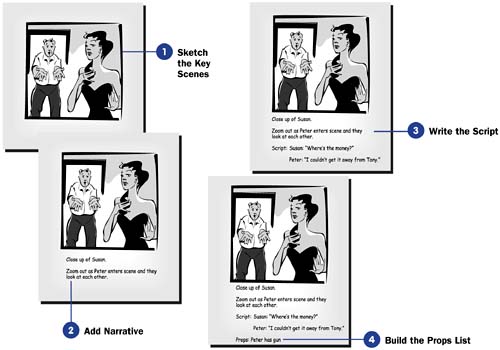Before You Begin  1 Walk Through a Digital Video Production 1 Walk Through a Digital Video Production
See Also  6 About Shooting Tirelessly and Editing Relentlessly 6 About Shooting Tirelessly and Editing Relentlessly
Most video projects, including Hollywood blockbusters, benefit from a bit of planning and preparation. One of the first things you should do when you set out to make a video is to storyboard it. The storyboard describes the events of your movie in a thumbnail form. By looking through, changing, replacing, and rearranging the thumbnail images and descriptions on the storyboard, your movie plan shapes up, and you'll waste less time and film later when you're ready to shoot your movie. KEY TERM  | Thumbnail ” A small picture that represents a scene or a larger picture. |
If you do a good job creating a storyboard, you'll have an easier time filming your video. Remember, however, that you might need to revise your storyboard when you get into the editing stage. Be thinking about special effects, music, and titles which you won't add during the storyboarding stage but you will need to add in the editing stage. NOTE  | Movie makers often use the term storyboard as a verb, as in "to storyboard a movie." They think they sound cool when they do that. |
- Sketch the Key Scenes
Think of your storyboard as a cartoon that describes, scene by scene (or even frame by frame), what happens in your movie. Draw all the events depicting the video from key camera angles you intend to shoot. You can use a storyboard as a road map to filming the video.
- Add Narrative
Under each frame, describe what is happening, who is in the scene, and what everyone is saying. You can also describe the mood or any other key elements.
- Write the Script
NOTE  | Obviously, if you're planning to shoot an event such as a birthday party, storyboard planning is overkill. For any instructional or entertainment video, however, you will save a great amount of time and frustration by storyboarding. | At this stage, it's also important to write a script that identifies what everyone is going to say. The script will help identify any weaknesses in the storyboard and flesh out the video you are about to film.
- Build the Props List
Describe in detail any costumes, props, and other essential items under each frame of the storyboard where appropriate. Keep adding storyboard items to flesh out your video. Between scenes, add transitional effects you'd like to see and make notes of special effects you'd like to add to the video on certain scenes. Also, make notes of soundtrack music you might want to add in certain places if you think of something special. When done, your storyboard panels will appear, when you place them side-by-side, like a cartoon that shows your movie's sequence and requirements.
NOTE  | Your storyboard is not only a sequential layout of your movie, but it's also a great place to put notes you'll refer to during the movie's filming and post-filming production. |  |


